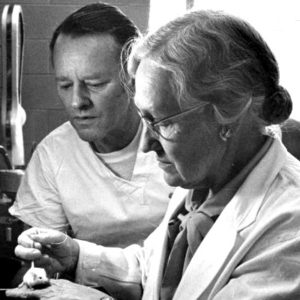calsfoundation@cals.org
Typhoid
Typhoid is among the earliest diseases reported in Arkansas and was a significant public health problem up through the early twentieth century. Though it became less common in the modern era, typhoid had a significant impact upon state health in times and places where poor sanitation was the norm.
Typhoid, like cholera, is transmitted through the ingestion of food or water that has been contaminated with the feces of an infected individual; the spread of the disease is therefore greatly linked with a lack of proper sanitation. Victims experience high fevers, sweating, inflammation of the gastrointestinal tract, and diarrhea. In most cases, the disease is not fatal, though fevers can last well over a month. Some individuals may become asymptomatic carriers of the disease, meaning that they are capable of infecting others despite not manifesting any symptoms themselves. The most famous of these was Mary “Typhoid Mary” Mallon, who is known to have infected forty-seven people in New York.
Typhoid was not recognized as a specific disease until the nineteenth century; before that, it was simply lumped into the category of “fevers,” making it difficult to estimate the number of cases that occurred during the era of European exploration and settlement. Commandant Alexandre de Clouet reported on September 20, 1769, that everybody at Arkansas Post had come down with a fever as a result of high water; archaeologist Samuel Dorris Dickinson surmises, from the fact that the settlement’s drinking water was polluted, that this might have been an early instance of typhoid in Arkansas.
More concrete reports on the disease occur during the Civil War, when typhoid proved a serious problem. Letters from soldiers report upon the scourge of typhoid in military encampments, where sanitation was often poor. At Camp Nelson in Lonoke County, where 20,000 Confederate soldiers were camped during the fall of 1862, the disease was responsible for a number of the approximately 1,500 deaths. After the war, typhoid and other diseases raged with a new virulence, especially in the camps housing Arkansas’s freedmen. The Arkansas Gazette reported that typhoid and other fevers claimed hundreds of victims in Little Rock (Pulaski County) alone.
In the 1890s, Holy Angels Convent relocated from Pocahontas (Randolph County) to Jonesboro (Craighead County) after several nuns contracted typhoid from local drinking water. Such contamination affected not only rural areas but also modern cities. According to the 1904 Report on the Origins and Spread of Typhoid Fever in U.S. Military Camps during the Spanish War of 1898, the First Arkansas Voluntary Infantry, a regiment mustered into service in Little Rock on May 19, 1898, likely brought typhoid into the training camp at Chickamauga Park in Georgia; the First and Second Arkansas infantries experienced numerous cases of typhoid. In 1911, Little Rock was threatened with a typhoid epidemic. In response, the newly elected mayor, progressive-minded Charles Edward Taylor, replaced the city board of health with a full-fledged health department with the power to tackle unsanitary conditions in the city. He also instituted sanitary regulation, began garbage collection, expanded the sewer system, and instituted the monitoring of drinking water. Before his reforms, the city experienced thirty deaths a year from typhoid; in 1912, there were only seven.
The first effective typhoid vaccine was developed in 1897 by British bacteriologist Almroth Edward Wright. U.S. Army physician Frederick F. Russell, who was sent to England to observe Wright’s research and work, instituted in 1910 an inoculation program within the army that soon became a model for typhoid vaccination. Arkansas native Margaret Pittman, who joined the National Institute of Health in 1936, spent much of her career involved in the production and testing of vaccines for numerous diseases, including typhoid.
In 1925, the Arkansas Department of Health (ADH) mandated that cases of typhoid be reported to the agency within twenty-four hours of diagnosis. That year, 1,367 cases were reported. However, the number of cases declined thereafter, save for temporary increases in the early and late 1930s. Outbreaks of typhoid occurred during the Drought of 1930–1931, an effect of people drinking unsanitary water. During the Flood of 1937, field hospitals for evacuees provided immunizations against the disease. The ADH supplied the public with vaccines against various diseases, typhoid being among them, during the Depression.
In Arkansas, as improved sanitation spread to even rural areas of the state, and due to improved vaccines, the number of cases followed the same downward trend as nationally. Between 1975 and 1979, only twenty-three cases were reported. Typhoid is increasingly rare, though not yet completely eradicated in the state.
For additional information:
Dickinson, Samuel Dorris. “Health and Disease in Early Arkansas, 1541–1803.” In Contributions to Arkansas Medical History: History of Medicine Associates Research Papers. Vol. 1, edited by Edwina Walls. Charlotte, NC: Delmar Printing Company, 1990.
“State Typhoid Fever Cases Show Decline during 1970.” Arkansas Gazette. December 27, 1971, p. 9A.
White, Paul C., Jr., R. C. Walls, and E. A. Gresham. “A Review of Reported Cases of Typhoid Fever and Documented Carriers in Arkansas.” Journal of the Arkansas Medical Society 79 (June 1982): 47–50.
Staff of the CALS Encyclopedia of Arkansas
 Margaret Pittman
Margaret Pittman  Typhoid Innoculation
Typhoid Innoculation 




Comments
No comments on this entry yet.